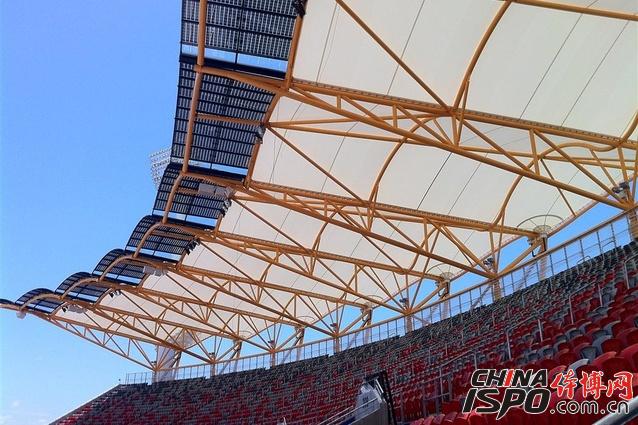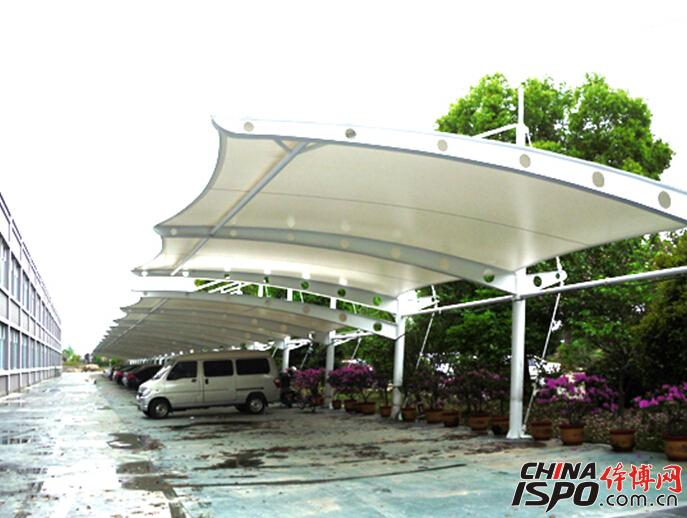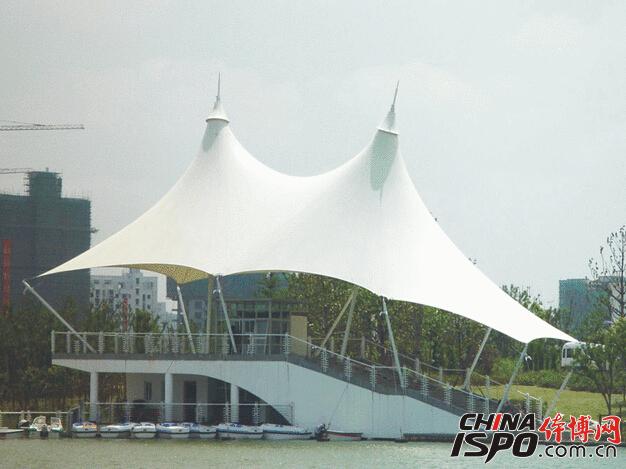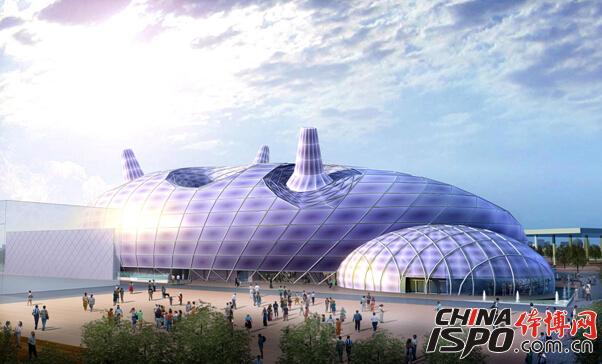Membrane structure introduction
Membrane structure is a structural system that perfectly combines architecture and structure. It is the use of high-strength flexible film material combined with the support system to form a stable surface with a certain degree of rigidity, which can withstand the spatial structure of a certain external load. Its advantages of being light, lightweight, flame-retardant, simple to make, quick to install, energy-saving, easy to use, safe, etc., make it widely used throughout the world. This type of structure is particularly suitable for large stadiums, corridors of people, small items, public entertainment plazas, fairgrounds, and shopping centers.

Membrane structure is also called Tensioned Membrane structure. It is a brand-new architectural structure developed in the middle of the 20th century. Its development has triggered a completely new concept of architecture. It is based on architectural fabrics, ie membrane materials. The structure system for tensioning the main body, together with the support member or cable, in detail: a variety of high-strength thin film materials (commonly known as PVC, PTFE, and silicone) and auxiliary structures (common steel Cables, steel trusses, steel columns, etc.) have a certain amount of pretensioning stress inside them, and form a spatial pattern under stress control, as the cover structure or building as the main body, and have enough strength to resist A spatial structure of external loads; it is one of the main forms of large-span spatial structures due to its novel and unique architectural shape and good stress characteristics.
Tensile film structure is based on the tensile stress of the film itself and support rod and cable together constitute the body system. Under the sunlight, the interior of the building covered by the membrane is filled with natural diffuse light. Without the contrast between the highlight surface and the shadow, the indoor visual environment is open and harmonious. At night, the lights in the building illuminate the night sky through the membrane of the roof, and the building's body shape shows a fantastic effect. The tensioned membrane structure is particularly suitable for the construction of roofs of urban landmarks, such as sports and recreational venues, shopping malls and restaurants that require advertising effects. The transportation hub of the city is the key building of the lifeblood of the city. The use of functions requires that the signs of the various building units of the building be clear. As a result, more and more buildings of this type have adopted membrane structures in recent years. The service life of architectural membrane materials is more than 25 years.
During use, the mechanical shape of the material can be kept stable under snow or wind load. The Student Activity Center at La Verne University in California, built in 1973, is a 23-year-old tensioned membrane structure. Tracking test and material loading and accelerating climate change tests demonstrate the mechanical properties and chemistry of its membrane materials. The stability index has dropped by 20% to 30%, but it can still be used normally. The surface of the membrane is smooth and elastic. The particles of dust and chemical substances in the atmosphere are extremely difficult to adhere to and penetrate. The rainwater scouring the architectural membrane can restore its original clean surface and light transmission.
Tensegrity is a self-stressing, self-supporting mesh rod structure composed of a series of continuous rods and continuous or discontinuous pressure rods. The meaning of “discontinuous rods†is The ends of the struts do not contact each other, ie only one strut is connected to one node. Tensegrity is a structural idea first proposed by American architect RB Fuller. He believes that the operation of the universe is carried out according to the principle of tension, that is, gravity is a balanced tension network, and each planet is an isolated point in this network. The cable net in this kind of structural system is equivalent to the universal gravitation in the universe, and the independent compressed bar is equivalent to the planet in the universe.
Membrane structure architectural features
Transparency - Bright space filled with natural light
During the day, sunlight penetrates the membrane and fills the building with natural diffuse light. At night, indoor lights add a fantastic night view through the membrane to the night sky. When the membrane structure is used in gymnasiums and entertainment facilities, it is possible to realize a large space of all weathers, creating an ideal commercial space that combines outdoor refreshment and indoor comfort.
Fire resistance and durability - ideal for construction membrane materials
Membrane structures using PTFE membrane materials have properties such as heat resistance, weather resistance, drug resistance, high strength, and fire resistance, and they are not susceptible to aging, and they can retain their initial strength after long-term use.
Self-cleaning - keep white and beautiful from beginning to end
The surface coating of PTFE membrane material is PTFE resin, which is the same as the coating of non-stick surface used in our daily life. Its greatest feature is its extremely high non-adhesiveness. It is not used in our daily use. You can feel this feature when you touch the pot. The surface of PTFE membrane material is not only difficult to adhere dirt and dust, but also the dust on the surface will be washed naturally by rain, so after years of use, the appearance of cleanliness and interior beauty is maintained.
Long Span - Columnless Space
Membrane materials used in membrane structures are light, weighing only about 1 kilogram per square meter. Therefore, the membrane structure can fundamentally overcome the difficulties encountered by conventional structures in column-free and large-span buildings, and can create a huge column-free space.
In snowy areas, avoiding the maintenance and management of buildings suffering from heavy snowfall requires a certain amount of manpower and financial resources. It is a problem for technicians to reduce their costs as much as possible. Membrane roofs of membrane structures are less prone to snow than other roof materials, and they will automatically fall as long as there is a relatively small angle of snowfall. Moreover, since the thermal conductivity of the PTFE membrane material is small, if snow melting equipment is used to perform detailed snow melting operations, the effect of the heating device can be fully utilized, and the roof slope can be made smaller.
Comfortable Space - Freestyle
Multi-purpose membrane structure The most representative and promising building form in the 21st century, it breaks the pattern of past architectural forms and becomes a symbolic building of the city with its unique and novel, colorful shapes and beautiful curves.
Lightweight structure - Resilience and disaster relief
Membrane materials are much lighter than other building materials, and buildings with membrane materials on the roof have extremely strong seismic resistance and good safety. In addition, in the event of a disaster, a multi-purpose facility with a membrane structure and a gymnasium are used. The column-free, bright, large space can be used as a temporary evacuation site, emergency center, and disaster prevention headquarters. Therefore, membrane structures can protect people's safety in times of crisis.
Membrane structure advantages over traditional architectures
Lightweight structure
The weight of the membrane structure is much lower than that of the conventional architecture (approximately 1/30), and the support and the basic components can be greatly reduced.
Shape diversity
Flexible materials, free-space surfaces, non-repetitions, and multiple variations.
Landscape effect
The novel and unique membrane architectural style not only highlights individuality and splendour, but also timely and appropriate fusion of the surrounding scenery, complement each other. Night light through the regulation, a beautiful landscape.
Structural durability
The tensile strength of commonly used film materials reaches 3000--6000N/5CM, which is close to or reaches the tensile strength of steel materials. The pre-stressing process makes it less creep and durable.
Structural economy
Membrane and steel structure are completed in the factory, and there are few on-site operations, which can shorten the construction period by 70-80% and save construction expenses.
Transparency and high thermal radiation
Due to the high reflection and low absorption of sunlight, the consumption of indoor air conditioners is reduced. Its translucent nature allows the light source to spread evenly, reducing the power consumption of lighting and creating a comfortable interior space.
Reduced build time
Since the processing of the film (cutting, welding, and other steps) has been completed in advance in the factory, the on-site assembly has been handed to skilled staff, which greatly shortens the construction time compared with the simple procedures of traditional construction.
Membrane structure classification
Membrane structure according to structural force characteristics can be roughly divided into inflatable membrane structure, tensile membrane structure (Tension/Suspension membrane structure), skeleton membrane structure (Frame membrane structure, Frame dome membrane structure, combined membrane structure (Compound There are several major categories such as membrane structure.
Membrane structure type
From the structure can be roughly divided into skeleton type, tension type, inflatable membrane structure in three forms
1. Frame Supported Structure

After the roof frame is made of steel structure or glulam, the structure of the tensioned membrane material above it, the lower support structure is highly stable, the roof shape is relatively simple, the opening is not easily constrained, and the economic benefits are high. Suitable for any size of space.
2. Tension Suspension Structure

It consists of membranes, steel cables and struts. Tension is introduced into the membrane using steel cables and struts to achieve a stable form. In addition to being able to practice innovative, aesthetically pleasing shapes, it is also the form of construction that best represents the spirit of the membrane structure. In recent years, large-span space has also used steel cables and compressed materials to form steel cable nets to support the upper membrane material. The construction requires high precision, strong structural performance, and rich expression, so the cost is slightly higher than the skeleton membrane structure.
3. Inflatable membrane structure (Pneumatic Structure)

The inflatable membrane structure fixes the membrane material to the periphery of the roof structure and uses the air supply system to increase the pressure in the chamber to a certain pressure, so that the pressure difference between the inside and the outside of the roof is generated to resist the external force. The pressure is used to support and the steel cable is used as an auxiliary material. Without any beam or column support, more space is available, the construction is quick and the economic benefits are high. However, it is necessary to maintain the operation of the blower for 24 hours, which is high in the cost of continuous operation and machine maintenance costs.
Membrane structure according to structural force characteristics can be roughly divided into inflatable membrane structure, tensile membrane structure, skeleton membrane structure, combined membrane structure and other four categories.
The inflatable membrane structure can be further divided into an air-bearing membrane structure, an air-bath type membrane structure (or a ribbed membrane structure), and a combined gas membrane (air-bath type and air-rib type).
The air-bearing membrane structure is inflated through the pressure control system to the interior of the building. It maintains a certain pressure difference both inside and outside the chamber. The membrane body is subject to buoyancy and generates a certain pre-tension to ensure the rigidity of the system. The indoor air pressure automatic adjustment system is set to constantly adjust the indoor air pressure to adapt to changes in external loads.
The inflatable membrane structure is an integral force system that inflates a single membrane component to maintain sufficient pressure and a plurality of membrane components are combined to form a certain shape. This structure requires high air tightness of the membrane material itself. Or, it is necessary to continuously inflate the membrane structural member.
Tensile membrane structure is an important part of modern membrane structure architecture. The membrane surface is generally a negative Gaussian surface. Therefore, the rich body shape, natural smoothness, and soft surface are favored by architects. However, this type of structural system is difficult to analyze and has a high requirement for construction accuracy. Therefore, the design calculation and processing technology are more difficult.
Skeleton membrane structure is self-closed, stable framework system (usually steel truss system, grid structure, cable net structure or tensioning system) and membrane material together to form a structural stress system. The system construction should be similar to the conventional one (except the self-construction of the cable net or the tension system etc.), which is easier for the engineering community to understand and accept. However, in order to allow the membrane to have a certain rigidity, the skeleton system provides the support system for the membrane. There must be a certain degree of curvature and a mechanism for prestressing the membrane should be provided.
Membrane structure applications
Nowadays, more and more membrane structures can be seen in cities. Membrane structures have been applied to various types of architectural structures and are playing an indispensable role in our cities:
Sports facilities: Stadium / gym / Tennis court / Swimming pool / Training center / Fitness center, etc.
Commercial Facilities: Shopping/Amusement Center/Hotel/Restaurant/Commercial Street
Cultural Facilities: Exhibition Center / Theater / Performance Center / Aquarium, etc.
Transport facilities: airport / train station / pier / parking lot / overpass / gas station / toll station etc.
Landscape Facilities: Landmarks / Square Signs / Community Landscapes / Walking Streets, etc.
Industrial facilities: factory/warehouse/sewage treatment center/logistics center/greenhouse
Laser jet printer
Laser jet printer uses software to deflect laser beam and directly burns the surface of the product to be marked by laser at high temperature to form fonts or patterns.
The advantages of laser jet printer are as follows:
1. Reduce production costs, reduce consumables and improve production efficiency.
2. Anti-counterfeiting effect is obvious. Laser code-jet technology can effectively inhibit the counterfeiting of product identification.
3. It is helpful for product tracking record. Laser jet printer can print out the batch date and shift of the product. It can make every product get good tracking performance.
4. Increasing the added value can make the product look better. Promote the brand awareness of products.
5. The equipment is reliable, the Laser Marking Machine has mature industrial design, stable and reliable performance, can work 24 hours continuously, and the laser maintenance-free time is more than 20,000 hours. Temperature adaptability range is wide (5 - 45 C), which is widely used in various industries in the field of production and packaging.
6. Environmental protection and safety. Laser typewriters do not produce any chemicals harmful to human body and environment. It meets GB7247-87 and GB10320-88 standards. It is an environmental-friendly high-tech product.
7. Laser jet printer can print a large amount of data in a very small range. Laser can mark the product material with very fine beam. The printing accuracy is very high, the control is accurate, the content of jet printing is clearly and perfectly interpreted. It has strong market competitiveness, environmental protection and safety, without any corrosiveness, and completely isolates chemistry. Pollution is also a kind of intimate protection for operators, which ensures the cleanliness and tidiness of the production site, reduces the investment in the later period, and reduces noise pollution.
Human beings have reached an unprecedented height in their understanding of environmental protection and effective utilization of resources. It has become the consensus of developed countries and most developing countries, including China, to eliminate the backward equipment and production processes that cause environmental pollution and waste of resources to the greatest extent. Because the dot matrix ink typewriter has four difficult problems: high pollution, high consumables, high failure and high maintenance, which can not be overcome. Especially the chemical pollution caused by dot matrix ink typewriter in use can cause harm to the environment and operators.
Laser Marking Machine
Laser Marking Machine,Laser Marking Equipment,Laser Marking Machine For Metal,Portable Laser Marking Machine
GUANGZHOU INCODE MARKING TECHNOLOGY CO., LTD. , https://www.gzincode.com